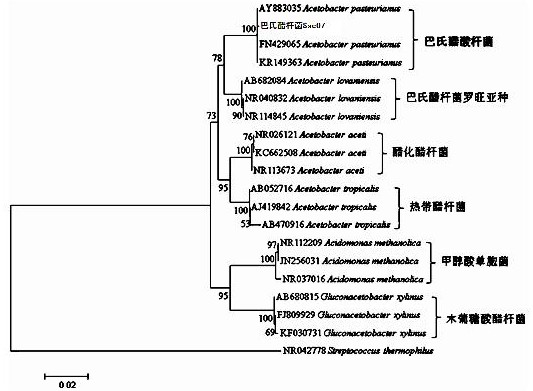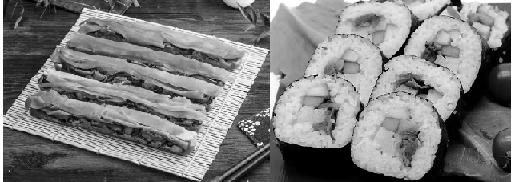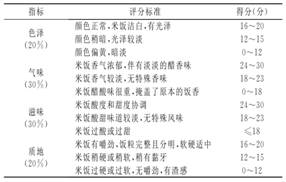A kind of sushi vinegar acetic bacteria and method for fermenting sushi vinegar and application in sushi
A technology of sushi vinegar and acetic acid bacteria, which is applied in the field of microbial isolation and fermentation, can solve the problems of isolation and research of unfermented strains, and achieve the effect of excellent alcohol resistance, mild taste, and soft entrance
- Summary
- Abstract
- Description
- Claims
- Application Information
AI Technical Summary
Problems solved by technology
Method used
Image
Examples
Embodiment 1
[0036] Example 1 Screening of Acetobacter pasteurii Ssc07
[0037] (1) Microbial enrichment culture
[0038] Take 1-3 g of vinegar fermented grain samples from the 3-6 days of Japanese white chrysanthemum vinegar fermentation, and the sampling position is 15 cm away from the surface of the vinegar fermented grains. Counting 180 rpm, enrichment culture at 42 °C for 36 hours.
[0039] Composition of enrichment medium: glucose 20 g / L, yeast extract 15 g / L, ethanol 4% (v / v), acetic acid 5 g / L.
[0040] (2) Gradient screening with acetic acid and ethanol for continuous enrichment and purification
[0041]The fermentation broth obtained in the above step (1) was transferred to a shake flask with 100 mL of enriched medium at an inoculum volume of 10% (v / v), and the rotation speed of the shaker was 180 rpm at 35 °C. Condition for enrichment and culture, and transfer to fresh enrichment medium after 36 hours.
[0042] The enrichment medium consists of: glucose 20 g / L, yeast extract...
Embodiment 2
[0047] Example 2 Performance Analysis of Acetobacter Pasteurella Ssc07 Fermentation Products
[0048] (1) Preparation of seed solution
[0049] Acetobacter pasteuriana Ssc07 was taken from the slant and inoculated into the seed medium, incubated at 37 °C, 160 rpm for 24 hours on a shaker, and transferred at an inoculum of 10% (v / v). Scale up in fresh seed medium.
[0050] Seed medium composition: glucose 20 g / L, yeast extract 15 g / L, ethanol 3.5% (v / v).
[0051] (2) Acetic acid fermentation
[0052] According to the inoculation amount of 10% (v / v), the seed liquid of Acetobacter pasteuriana Ssc07 obtained in (1) was respectively inoculated into a fermenter for acetic fermentation. During the fermentation process, the fermentation temperature was controlled at 37 °C, and the ventilation rate was 1:0.1 (v / v) / min.
[0053] The fermentation medium consists of: glucose 30 g / L, yeast extract 20 g / L, ethanol 7% (v / v), acetic acid 10 g / L, MgSO 4 0.1 g / L, CaCl 2 0.2 g / L.
[00...
Embodiment 3
[0064] Example 3 Production of sushi vinegar by fermentation of Acetobacter pasteurianus Ssc07
[0065] (1) Raw material pretreatment: select sugar-containing raw materials without mildew and impurities, remove impurities, wash and dry the soil and microorganisms on the sugar-containing raw materials with clean water, then pulverize and pass through a 60-mesh sieve; The raw materials used in the fermentation are rice, millet, sorghum, and corn (about 50:10:10:10 by weight), supplemented with apples and hawthorn (about 5:1 by weight). Ratio, 90:10 by weight.
[0066] (2) Add 10 times the weight of water to the pulverized raw materials, and add commercial high-temperature amylase, heat up to 80°C, maintain pH at 6.0, and keep warm for 45min;
[0067] (3) Add commercial koji refined koji to the bran, and ferment at 35°C for 40 hours;
[0068] (4) Mix the pretreated saccharide-containing raw material and bran in a weight ratio of 4:1, add saccharification enzyme, and saccharify ...
PUM
| Property | Measurement | Unit |
|---|---|---|
| diameter | aaaaa | aaaaa |
Abstract
Description
Claims
Application Information
 Login to View More
Login to View More - R&D
- Intellectual Property
- Life Sciences
- Materials
- Tech Scout
- Unparalleled Data Quality
- Higher Quality Content
- 60% Fewer Hallucinations
Browse by: Latest US Patents, China's latest patents, Technical Efficacy Thesaurus, Application Domain, Technology Topic, Popular Technical Reports.
© 2025 PatSnap. All rights reserved.Legal|Privacy policy|Modern Slavery Act Transparency Statement|Sitemap|About US| Contact US: help@patsnap.com



